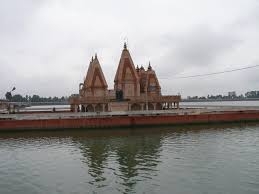

The most famous religious destination in India and one of the oldest pilgrim destinations of the world, Kurukshetra is located in Haryana district. Kurukshetra derives its name from King Kuru, whose name is closely connected with the sacred epic of Hinduism, Mahabharata.
Kurukshetra was the venue of the legendary battle that took place between the Pandavas and the Kauravas, in which Pandavas seized the ultimate victory with the help of Lord Sri Krishna. It was on this battlefield that Lord Sri Krishna gave his advice to Arjuna the brave warrior of Pandavas, who was baulked when it came to going to battle with his close relatives. Lord Krishna’s advice to Arjuna forms the slokas of the Shrimad Bhagavad Gita through which he declares Kurukshetra as the ‘Dharmakshetra’, the land of Dharma, the abode of righteousness.
Kurukshetra is believed to be a city as old as the Rigveda, the most important of the four Vedas. The prime attractions of present day Kurukshetra are Ban Ganga, Bhishma Kund, Brahma Sarovar, Sannihit Sarovar, Jyotisar, Sri Krishna Museum, Gurudwara at Kurukshetra, Panorama, Sheikh Chehli Mausoleum and Sthaneshvara Mahadev Temple. It is believed that Ban Ganga is a spring made by an arrow from Arjuna’s bow to quench the thirst of his tired horses during his search for Jaidrath to fulfill his pledge that to kill Jaidrath by dusk. Presently, one can see a water tank at the spot which is worshipped as the Ban Ganga, along with images of Mahabharata heroes and a Hanuman temple. Bhishma Kund is another such spring located at Naraktari, which was created when Arjuna shot an arrow towards the earth to satisfy the thirst of Bhishma, the great grandfather of the Pandavas and Kauravas.
Brahma Sarovar is a sacred water body, which according to mythology was conceptualised by Brahma, the creator one of the Trimurtis. The water of Brahma Sarovar is considered sacred and a dip in its waters, sacrosanct. Sannihit Sarovar is another sanctified water body in Kurukshetra where the waters of all pilgrim centres merge on new moon day. It is believed to be the permanent abode of Lord Vishnu. Jyotisar, which means the source of light, is one of the holiest places of Kurukshetra, the birthplace of Bhagavad Gita, where Lord Sri Krishna delivered the holy scripts of Bhagavad Gita to Arjuna. According to legend, Lord Brahma laid the first Shiv Linga at the Sthaneshwar temple here. The Lakshmi-Narayan temple, Bhadra Kali temple, Pathari Masjid and several archaeological trails identified through excavations make Kurukshetra a perfect pilgrim destination. The Sikhs too consider Kurukshetra as a place of great sanctity as the nine of the ten first Sikh Gurus had visited Kurukshetra. There are several Gurudwaras in Kurukshetra town.
A relatively modern day attraction at Kurukshetra is the Sri Krishna Museum opened in 1991 by the Kurukshetra Development Board. It showcases various objects of art presenting Krishna as God, a reincarnation of Lord Vishnu, a great philosopher, a wise statesman and an ultimate lover. Another interesting must-see is the Panorama Project managed by the National Council of Science Museums. The Panorama Project is a cylindrical structure, 34 feet high, portraying the Mahabharata battlefield. Kurukshetra is located 150 km from Delhi and 95 km from Chandigarh. It is well connected by roads and rail. The nearest airports are Delhi and Chandigarh.
